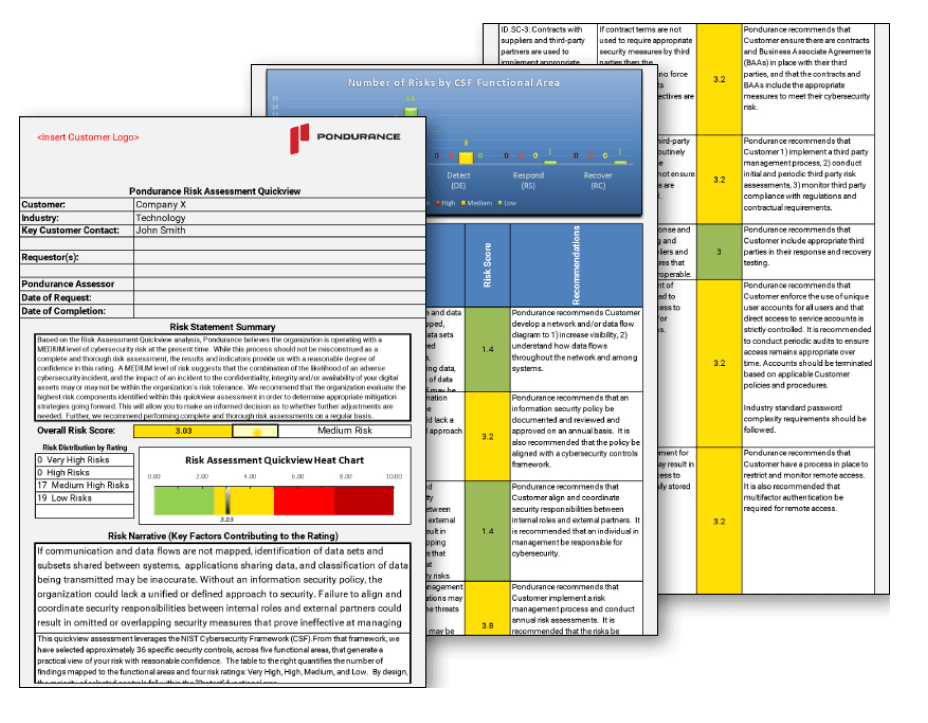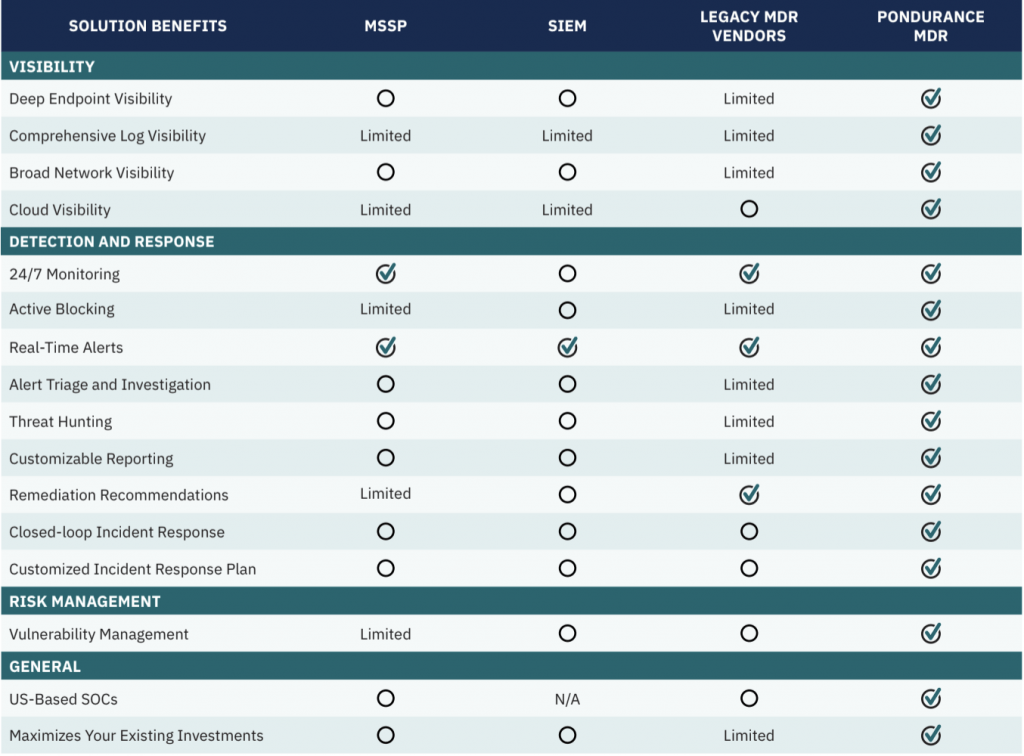

We thought we had been making the right security investments. Then we had an incident and brought in Pondurance. They immediately proved their value and earned our trust due to their immense expertise and guidance throughout the entire process. We simply wouldn‘t have been successful without them.
Steve Long, President & CEO, Hancock Health
Want to review more case studies? LEARN MORE

Download our comparison chart to see the difference between SIEMs, MSSPs, other MDRs and Pondurance MDR.




In the rapidly evolving landscape of cybersecurity, organizations are increasingly relying on advanced tools and techniques to protect their networks and endpoints from cyber threats. Among these solutions, managed detection and response (MDR) and endpoint detection and response (EDR) have emerged as popular choices for businesses looking to bolster their security posture. Understanding the differences between these approaches is essential for selecting the most appropriate solution for your organization.
Managed detection and response (MDR) is a comprehensive cybersecurity service designed to provide expert monitoring, threat identification, incident response, and ongoing security improvement. MDR security utilizes a combination of technology, human expertise, and processes to detect potential threats within an organization’s network in real-time. This proactive approach allows businesses to swiftly address any detected issues before they can escalate into more severe problems or result in data breaches.
Endpoint detection and response (EDR), on the other hand, focuses primarily on securing an organization’s endpoints – such as laptops, desktops, and mobile devices – from advanced threats like ransomware endpoint detection. EDR tools monitor these devices continuously for signs of suspicious activity or potential attacks by leveraging advanced analytics capabilities. In case of any identified threat, EDR solutions automatically respond with pre-configured actions or alert IT administrators to take necessary remedial measures.
The key difference between MDR and EDR lies in their scope and focus areas. While MDR takes a holistic approach towards securing an organization’s entire network through continuous monitoring and threat management services provided by external experts; EDR is specifically designed to protect endpoints from targeted attacks using specialized tools developed by software vendors or managed security service providers.
Extended Detection And Response (XDR), another term often used in discussions about cybersecurity solutions, represents an evolution of EDR that aims at integrating multiple layers of protection across various attack surfaces – including endpoints, networks, cloud environments, etc.; thus providing enhanced visibility and control over the entire threat landscape.
Organizations like Pondurance offer both MDR and EDR services to help businesses strengthen their cybersecurity posture. By leveraging industry-leading technology and experienced security professionals, Pondurance can provide customized solutions tailored to the unique requirements of each client, empowering them to protect their critical assets from potential cyber-attacks effectively.
In summary, MDR and EDR are essential components of an effective cybersecurity strategy for modern organizations. While MDR offers comprehensive network security through expert-managed services, EDR focuses on securing endpoint devices from advanced threats. Understanding these differences is crucial in selecting the right solution for your organization’s specific needs and ensuring a robust defense against evolving cyber risks.
Managed Detection and Response (MDR) and Extended Detection and Response (XDR) are two significant security solutions within the cybersecurity landscape, each offering unique advantages in protecting an organization’s digital assets. Both MDR and XDR aim to mitigate cyber threats by detecting, responding to, and preventing future attacks. However, it is essential to understand their differences in order to determine which solution best fits a company’s specific needs.
MDR focuses on providing continuous monitoring of an organization’s network traffic, endpoints, and other assets to detect potential threats. This is achieved through advanced analytics, machine learning algorithms, and expert human analysis that collaborates in real-time with automated incident response capabilities. With MDR services such as those offered by Pondurance, organizations gain access to specialized teams of cybersecurity experts who can help them bolster their defenses through threat hunting, threat intelligence analysis, and ongoing security recommendations.
On the other hand, XDR extends the scope of protection beyond traditional endpoints such as desktops or servers. It incorporates data from various sources like cloud environments, email systems, network devices, and applications into a single unified platform for enhanced visibility across all attack vectors. This comprehensive approach offers more contextual information for rapid threat detection and remediation while minimizing false positives.
One of the primary distinctions between MDR vs XDR lies in the level of integration they offer within an organization’s existing security infrastructure. While MDR mainly focuses on endpoint detection and response (EDR), XDR encompasses a broader array of tools like Security Information and Event Management (SIEM) systems that collect valuable data from multiple sources for more accurate analysis.
Furthermore, XDR platforms generally provide greater automation capabilities compared to MDR solutions. By correlating data from different sources automatically using advanced analytics techniques such as artificial intelligence (AI) or machine learning (ML), it enables faster identification of malicious activities without requiring manual intervention from security professionals.
However, choosing between MDR vs EDR or even XDR vs SIEM ultimately depends on an organization’s unique requirements and existing security frameworks. It is vital to assess the level of expertise and resources available in-house, as well as the specific threats faced by the business.
Organizations like Pondurance can help navigate these decisions by providing expert guidance and services tailored to each company’s individual needs. By leveraging their extensive industry experience, they can ensure that businesses are fully protected against cyber threats—whether through MDR, EDR, XDR, or a combination of these solutions.
What is MDR? Managed Detection and Response (MDR) has rapidly emerged as an essential component in today’s cybersecurity landscape. As cyber threats grow more sophisticated and pervasive, organizations of all sizes are turning to MDR services for comprehensive protection against these mounting risks. MDR is a collection of network-, host-, and endpoint-based security technologies that a third-party provider manages for a client organization. This strategic approach goes beyond traditional security measures by offering continuous monitoring, threat detection, incident response, and remediation services to protect businesses from advanced cyber attacks.
MDR security vendors play a crucial role in providing this comprehensive protection. In contrast to Endpoint Detection and Response (EDR), which focuses solely on endpoints such as laptops, desktops, and servers, MDR offers broader coverage by incorporating network- and host-based security controls alongside EDR capabilities. These vendors use advanced analytics, machine learning algorithms, and threat intelligence feeds to identify malicious activities that could potentially lead to data breaches or other security incidents.
A comparison between MDR vs EDR and MDR vs SIEM (Security Information and Event Management) highlights the unique benefits offered by choosing an MDR service over other cybersecurity solutions. While EDR primarily focuses on detecting threats at the endpoint level, MDR provides comprehensive visibility into an organization’s entire IT environment. Similarly, SIEM tools concentrate on collecting log data from multiple sources for analysis but may lack strong automation capabilities necessary for rapid threat response. In contrast, MDR providers deploy automated response mechanisms tailored to each client’s unique environment.
Top MDR providers like Pondurance have established themselves as industry leaders by delivering best-in-class managed security services that integrate cutting-edge technology with expert human analysis. Pondurance excels in both EDR services—employing advanced technologies like artificial intelligence (AI) and machine learning—to detect and prevent threats at the endpoint level—and managed SIEM solutions that provide real-time insights into potential vulnerabilities across an organization’s network.
By offering comprehensive, customizable, and intelligent security solutions, Pondurance stands out among its competitors as a top MDR provider. Businesses partnering with Pondurance can expect to benefit from proactive threat hunting, robust incident response capabilities, and ongoing cybersecurity education designed to empower organizations to stay one step ahead of cyber criminals. As a result, clients can have confidence in their ability to protect sensitive information, maintain regulatory compliance, and safeguard their reputation in an increasingly connected global marketplace.
Network Detection and Response (NDR) is a crucial aspect of cybersecurity that focuses on identifying, analyzing, and addressing suspicious network activity in real-time. This advanced approach to network security utilizes state-of-the-art technologies such as machine learning, artificial intelligence, and behavioral analytics to detect anomalies and potential threats. With the ever-evolving landscape of cyber threats, NDR has become an indispensable component in safeguarding organizations’ digital assets and infrastructure.
One of the most significant advantages of NDR lies in its non-signature-based detection methodology. Traditional signature-based methods rely on known patterns or signatures of malicious activity to identify threats. However, this approach leaves networks vulnerable to new or unknown threats that may not yet have defined signatures. In contrast, NDR leverages advanced analytical techniques to detect unusual network behavior or patterns indicative of potential threats – even those without a known signature.
A primary concern for many organizations is how to protect their networks from ransomware attacks effectively. Ransomware is a type of malicious software that encrypts an organization’s data, demanding payment for the decryption key. The implementation of NDR significantly reduces the risk posed by ransomware by promptly detecting anomalous behavior associated with such attacks. This early detection allows for a swift response and remediation before significant damage occurs.
Another essential aspect of network security is network penetration testing. This process involves simulating real-world attacks on an organization’s network infrastructure to identify vulnerabilities and weaknesses that could be exploited by malicious actors. Companies specializing in network penetration testing employ skilled professionals who use various tools and techniques to evaluate an organization’s defenses comprehensively.
Pondurance is one such company that offers comprehensive Managed Detection and Response Services across logs, endpoints, and networks. By providing monitoring, detection, incident response, threat hunting capabilities through their proprietary platform – Pondurance integrates Network Detection and Response with Endpoint Detection and Response (EDR). EDR focuses on monitoring individual devices within a network – like workstations, laptops, and servers – to detect and respond to potential threats. By combining NDR and EDR in their managed services offering, Pondurance delivers a holistic approach to cybersecurity that addresses the full spectrum of potential threats an organization may face.
In conclusion, Network Detection and Response is a critical component of modern cybersecurity strategies due to its advanced threat detection capabilities and ability to adapt to ever-evolving cyber threats. Organizations should consider implementing NDR as part of their overall security strategy while engaging with network penetration testing companies like Pondurance. These companies can effectively assess vulnerabilities within an organization’s infrastructure and provide tailored solutions for robust network security.